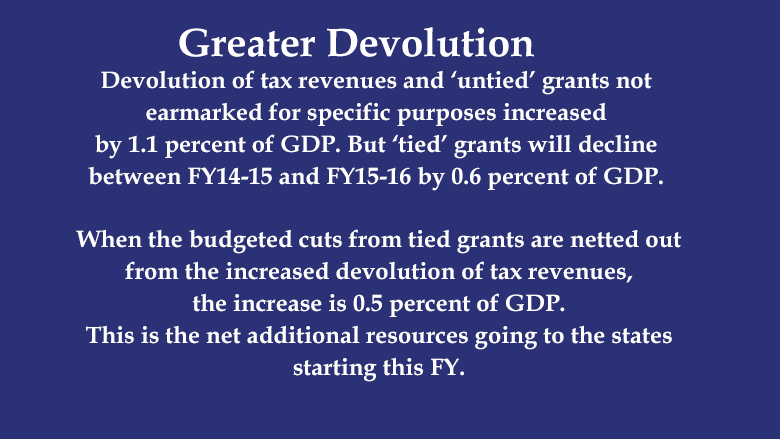NEW DELHI, October 29, 2015 – The Indian economy will continue to grow but acceleration year-on-year will be gradual, says the latest India Development Update of the World Bank.
According to the Update, India was able to take advantage of the sharp decline in global oil and commodity prices to eliminate petrol and diesel subsidies and increase excise taxes. Resources from lower subsidies and higher taxes has been well utilized in lowering deficits and increasing capital expenditure. Current account deficit narrowed 3.4 percentage point between financial year (FY) 12-13 and FY 14-15 (The financial years refer to fiscal year ending March 31.) and capital expenditure increased by one third in the first six months of calendar 2015 compared to the previous year. During the same period the construction sector expanded by 4 percent. The Update noted that while public investments have helped kick-start the investment cycle, increased participation of the private sector will be required going forward.
The Update, a twice yearly report on the Indian economy and its prospects, expects India’s economic growth to be at 7.5 percent in 2015-2016, followed by further acceleration to 7.8 percent in 2016-2017 and 7.9 percent in 2017-2018. However, acceleration in growth is conditional on the growth rate of investment picking up to 8.8 percent during FY2016-FY2018, it adds.
While growth will very likely remain above 7 percent in the next fiscal year, uncertainty about its momentum is high and downside risks ample. According to the Update, in the near term India is relatively well-positioned to weather the global volatility. Its low trade exposure to China and considerable foreign exchange reserves provide ample buffer. In the medium term, however, the Indian economy is not immune to a slowdown in global demand and heightened volatility. India requires some measure of foreign capital inflows to finance both fiscal and current account deficits and ultimately the investments to spur growth. China’s slowdown has further deteriorated India’s already weak export outlook. Although India may be able to achieve fast GDP growth without export growth for a short period, sustaining high rates of GDP growth over a longer period will require a recovery of export growth, the Update says.
“There are good reasons for confidence in India’s near-term prospects. To lay the foundation for sustainable growth and accelerate job creation, implementing the government’s reform program is key. While progress is visible in several areas, including improvements in the ease of doing business, some key reforms, most notably the implementation of the Goods and Services Tax (GST) can be a potential game changer for India,” said Onno Ruhl, World Bank Country Director in India.
For the economy to achieve its potential, the Update calls for three key domestic reforms. First, boosting the balance sheets of the banking sector by addressing the underlying challenges in the infrastructure sector, especially power and roads. The poor and deteriorating asset-quality of public sector banks is the biggest challenge facing the financial sector and a drag on credit growth, the Update says. Second, continuing to improve the ease of doing business and enacting the GST; and third, enhancing the capacity of states and local governments to deliver public service as more resources are devolved from the center.
“The most significant risks to the outlook stem from the banking sector and financing requirements of infrastructure companies. Public sector banks, which account for three-fourths of domestic credit, are under stress, with a rising share of non-performing. This restricts financing for private investment. Apart from the welcome capital injections and governance reforms that the Government is undertaking, ensuring a long-term solution to the debt overhang of infrastructure firms is needed to ensure sustainable financing,” Frederico Gil Sander, Senior Country Economist and Task Team Leader of the India Development Update.
Specifically the Update calls for the timely implementation of the GST in order to make India a truly single market and suggests the widest possible base for goods to be included under the GST. It suggests eventually bringing in alcohol, electricity, and real estate under the preview of the proposed GST, which are currently excluded from it. According to the Update, even though alcohol and petroleum account for over 40 to 45 percent of VAT/sales tax revenues for the states, there are few technical reasons for excluding them from the GST. Exclusion of electricity would mean that manufacturing firms are unable to claim credits for the duty they pay and are, therefore, taxed twice. In the case of alcohol, including it in GST would help address concerns about state excise rate arbitrage. Bringing real estate under the GST umbrella may complement the government’s efforts to curb undeclared ‘black money’ in the sector, the Update explains.
Another significant step taken by the government has been the greater devolution of the spending power from the center to the states and local bodies, it says. States are now responsible for 57 percent of the spending, which accounts for 16 percent of GDP. Of this, nearly 74 percent of the funds are untied (compared to an average of 57 percent during the 13th Finance Commission period), allowing more flexibility to states.

